Are you looking to bring a beautiful Poodle into your life?
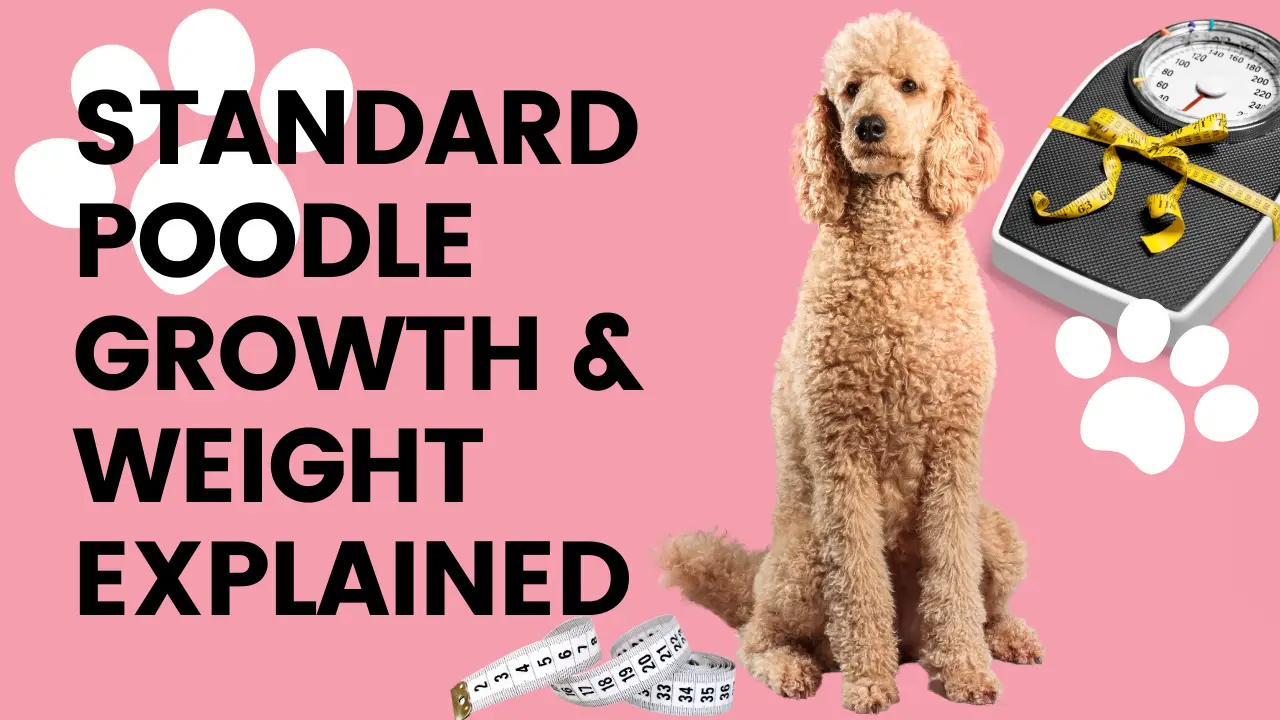
If so, then you’ll be definitely spoilt for choice. You have the option to pick three stunning types the Standard, Miniature, and Toy. That’s not even covering the 100s of different hybrid Doodle’s that exist.
While all are amazing, to help you with your Poodle buying decision, today we’re going to focus mainly on the Standard Poodle.

Read our Smart Poodles - Smart Tricks eBook for only $2.99
Dive into a treasure trove of engaging tricks and tips designed specifically for your poodle!
What Will You Learn? 👇
Standard Poodle Appearance
Standard Poodles are the largest Poodle breed out of the three types of Poodle. Typically this Poodle is known for its medium-sized structure. In addition to this, the Standard Poodle has a distinctly rounded skull, dark muzzle, dark oval eyes, and droopy ears. It also has a soft single-layered hypoallergenic coat in colors such as black, white, brown, ebony, red, grey, cream, blue, and more.
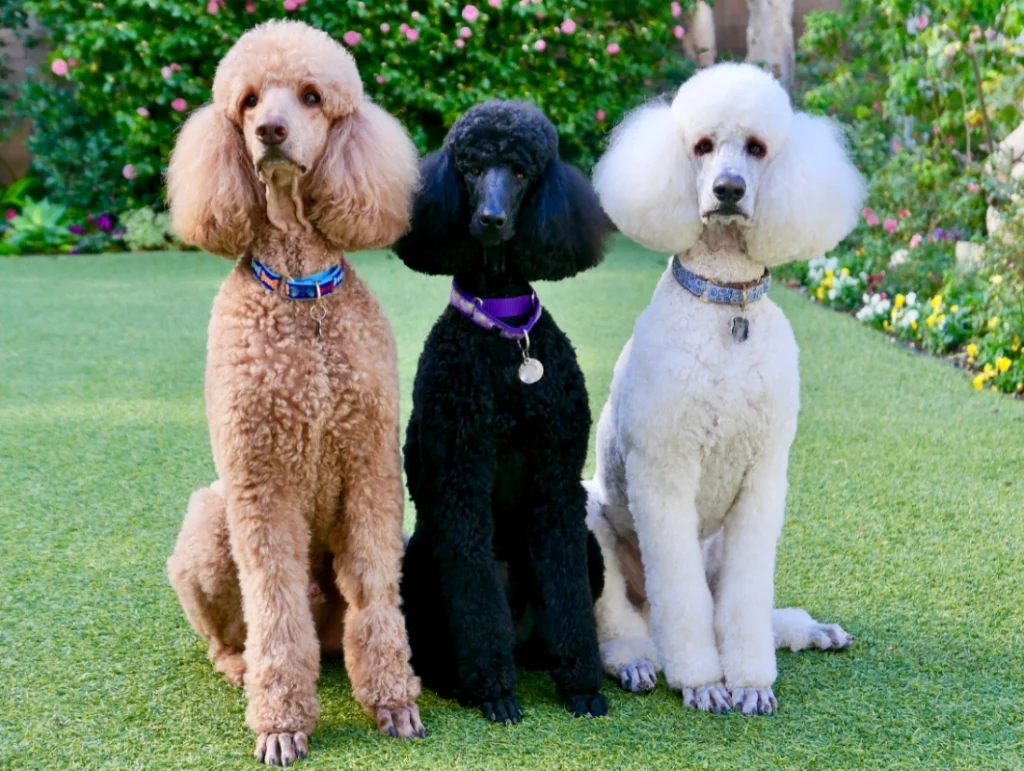
Are standard Poodles considered a large breed?
Compared to other dog breeds, the Standard Poodle is often classed as a medium to large-sized dog. On average, a Standard Poodle is often put in the larger category at dog shows due to its square structure. Typically a Standard Poodle can weigh between 45-70lbs / 20kg-32kg and grow up to 15-22 inches / 38-56cm.
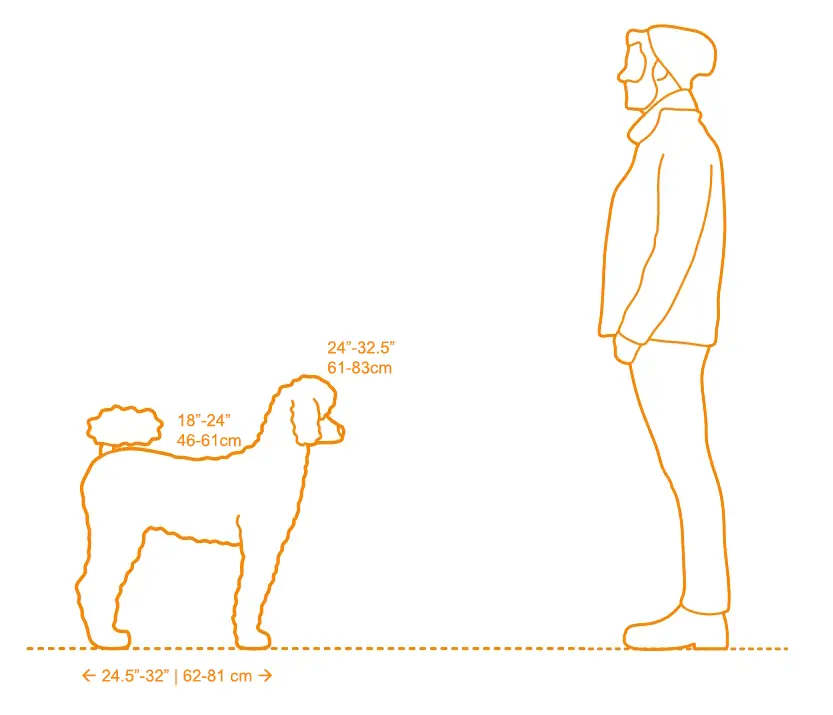
How long does a Standard Poodle grow for?
If you own a standard Poodle, it’s most likely you will see significant differences in their growth within the first year. Then after one year, their growth spurt will stop, and most likely, they will fill out in shape, giving them the square body structure they’re known for. After one year, it’s highly unlikely; their middle body will be skinny; you can expect the middle to fill out for up to 6 months. Then at around 18 months, it will reach its maximum height and weight!
Do note that over time, the rate at which your Standard Poodle grows will slow down.
At first, you might notice their weight doubling in size within the first 6 months or so, then it will decrease, and you may notice changes every odd month.
Also, there is an unofficial breed size known as the Giant Royal Standard Poodle, that I’ve written about so make sure you check it out as well, and yes they are really giants.
Stages of growth for a Standard Poodle
What you see underneath is a chart that demonstrates the different stages of growth for height and weight for a Standard Poodle.
| Age | Height in Inches | Height in Centimeters | Weight in Pounds | Weight in Kilos |
|---|---|---|---|---|
| Birth to 4 weeks | less than 10 | less than 25 | 4 to 5 | 1 to 2 |
| 4 to 8 weeks | 10 to 13 | 25 to 33 | 7 to 10 | 3 to 4 |
| 2 to 4 months | 13 to 19 | 33 to 48 | 10 to 22 | 4 to 10 |
| 4 to 8 months | 19 to 23 | 48 to 58 | 23 to 45 | 10 to 20 |
| 8 months to 1 year | 23 to 27 | 58 to 68 | 34 to 65 | 15 to 30 |
| 2 years (fully grown) | 24 to 27 | 60 to 68 | 38 to 70 | 17 to 31 |
If you get a Standard Poodle, it’s important not to take these figures too seriously as not every Standard Poodle will reach this growth range. Many factors can contribute to their growth, such as their parent’s size, health conditions, and gender.
To help understand this chart a bit better, let’s break the growth stages down for you.
Birth to 4 weeks
Upon birth and shortly after, you’ll find a Standard Poodle only being a few ounces up to a pound in weight, and they’re about less than 10 inches/25cm in height. Yes, they’re that tiny!
Don’t worry though, if you have a Standard Poodle right from birth, it won’t take them too long to grow. As soon as they get the right nutrients from their mother, you will start to notice significant differences from them in no time!
Then at around 3-4 weeks old, a Standard Poodle typically starts to get weaned off from its mother. During this phase, they tend to be 4-5lbs in weight, and from then onwards, they will gain weight around 1lbs a week.
4 to 8 weeks
If you’re looking to bring a Standard Poodle puppy home, the recommended time is between 6-8 weeks but more towards the 8 weeks. They grow up to 10-13inches/25-33cm in height and weigh between 7-10lbs/3-5kg during this phase.
This is also an important time in a Standard Poodle’s life as they get their first set of vaccinations to protect them from the outside world. It’s also essential that the vet visits a Standard Poodle to check for any growth abnormalities or illnesses in this growth period.
2 to 4 months
Do you remember earlier when I said that slowly a Standard Poodle’s growth takes longer to notice? Well, this is definitely now; we’re looking at changes on a 2 monthly period instead of weekly!
During this time, it’s important for a Standard Poodle to receive extra attention and proper nutrition to grow well and their bones can develop properly. On average, by the time they reach 4 months, they should be around 13-19 inches/33-48cm and weigh between 10-22lbs/5kg-10kg.
4 to 8 months
By this point, a Standard Poodle will slow down, and they start to enter their teenage years. During this time, you will find they will be highly curious about the world around them and start to explore more and sometimes causing mischief! On average, by the time a Standard Poodle reaches 6 months old, it should be around 19-23inches/48-58cm in height and weigh between 30-40lbs/13-18kg.
8 to 12 months
In the final one year period, a Standard Poodle should be reaching its maximum height. The final average growth for their height should be around 23-27inches/58-69cm and weigh between 45-70lbs/20-32kg. A soon as your dog has reached one year old, it’s important that you switch its food from puppy-based to one formulated for adult dogs.
You must do this to prevent them from becoming obese. Otherwise, they could become at risk of serious health issues such as diabetes, arthritis, and more if they do.
12 to 24 months
During 1-2 years, a Standard Poodle will reach their maximum weight of around 45-70lbs/20-32kg for males and 45-60lbs/21-27kg for females. They should also be at the height of around 24-27inches/60-69cm.
How much should a Standard Poodle eat per day?
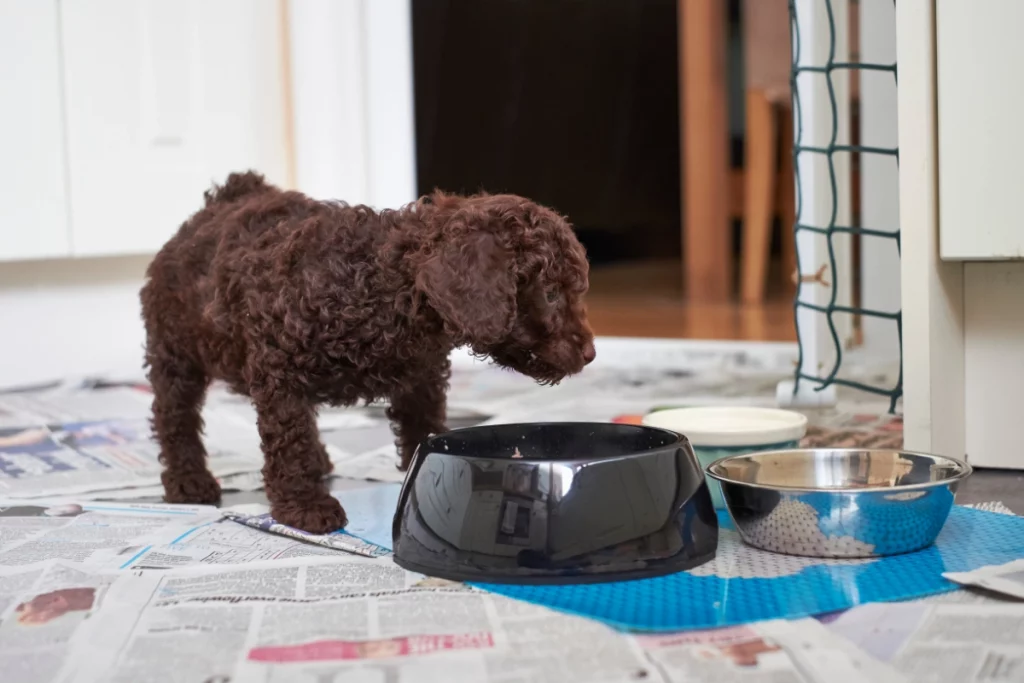
As mentioned earlier, food is essential to a Standard Poodle’s growth and development. When fully grown, the amount you feed them will really depend on the calorie content of the food. We cannot generalize, and owners should consult the feeding guidelines on the back of the packet, as they vary a lot. Do note that this is not the required amount for all Standard Poodles, in fact; it’s just a baseline.
Vet tip: Learn how to assess your dog’s body condition score, which is a very useful tool when it comes to determining if our Poodle is a healthy weight or not.
The amount of food they eat can depend on their age, dietary requirements, activity levels, metabolism, and more. To gain a better idea, you should consult with your veterinarian, who will give you an accurate guideline on their portion size, food brand, and the frequency they should be eating.
Generally, adult Standard Poodles need a smaller calorie intake, around 70-90 calories per kilogram. This is because adult Standard Poodles have a slower metabolism, and it takes longer for them to digest their food. It’s also important to know if your Standard Poodle has a large deep chest; they should have their meals split into two instead of one large one as some believe that this could cause them to experience bloat. It is also advised we avoid heavy exercise after a meal and that those who gobble food down quickly are given slow feeder bowls.
What do I feed a Standard Poodle puppy to help with their growth?
As a parent of a Standard Poodle, you can do a lot to contribute to their growth. First of all, you can make sure the food you’re giving them is designed for large breed puppies or adults.
You must do this to allow them to receive all the vital nutrients to grow and stay healthy. Compared to other puppy foods, they tend to have less calcium, fat, phosphorus, and vitamin D.
Reading that list, you might be surprised as many of these nutrients people feel are essential to healthy bone growth. However, there’s a lot of controversy surrounding this as there are studies that indicate high levels can contribute to joint problems and obesity. Therefore you must visit a vet and get a properly formulated meal plan.
What if my Standard Poodle is overweight or underweight?
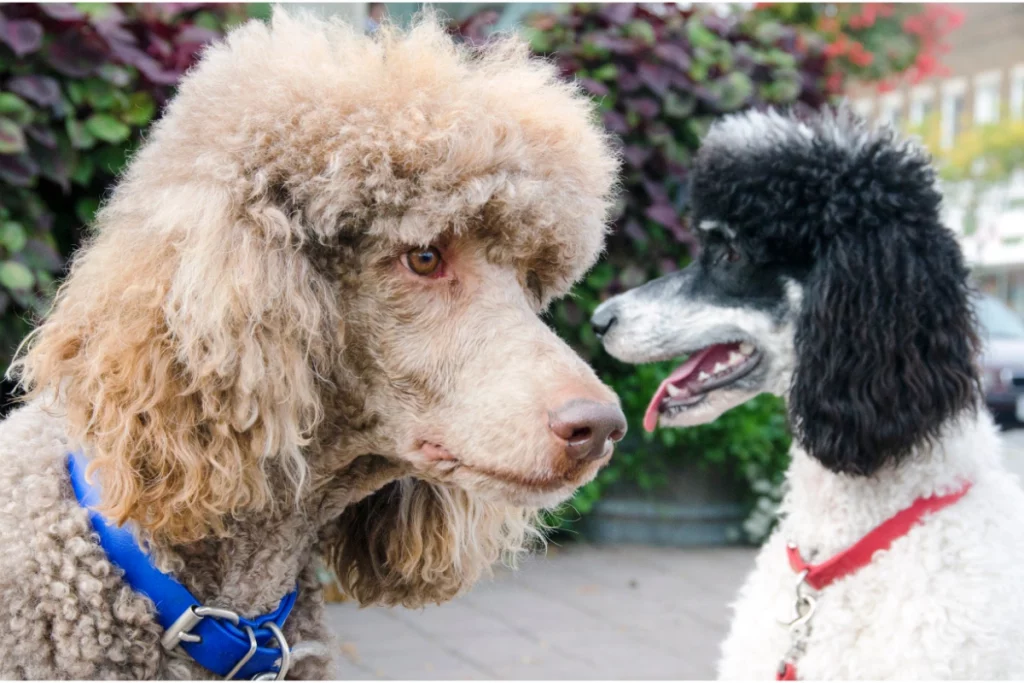
If you have a Standard Poodle and found your dog’s weight sitting outside the standard guidelines, then you should take action as it could be a sign they’re obese. To reduce a Standard Poodle’s weight, you should remove any treats, increase their exercise, and cut their portions sizes. How much we reduce portion sizes depends on how over-weight they are and the calorie content of the food.
It’s always important that you use your hands to feel around a Standard Poodle’s body to check if they’ve increased in weight. After all, their coats can be incredibly deceiving, hiding their weight without you realizing it.
On the contrary, if you find your Standard Poodle’s weight is sitting at the lower end of the scale, you should pay close attention to their food. Ideally, you will want to increase the amount of food they’re eating and add canned dog food to increase their chances of gaining weight.
The reason being is that canned puppy food tends to have more additives and be higher in calories, helping them gain more weight easily. If they still can’t gain much weight after this, you should consult the advice of a local vet who will look to see if they have any underlying health issues.
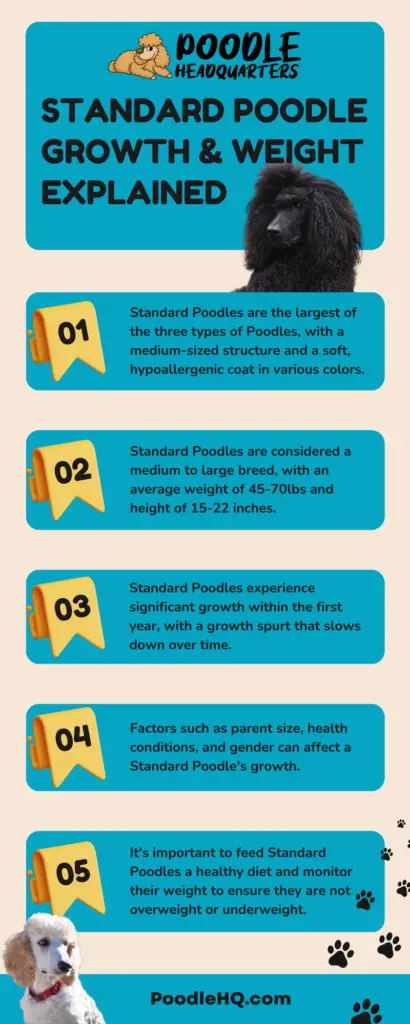
Final thoughts
Overall, Standard Poodles tend to be one of the most elegant dogs out of the three types of Poodle. You must review their body regularly with your hands as their coat can hide their weight. When looking at a growth chart of a Standard Poodle, you should be careful as their sizes and heights can vary based on their parents, nutrition, and gender! To make sure they’re healthy and their weight is in line, you should take them for frequent vet visits to check their weight and diet.
Marko is the founder and author at PoodleHQ, where he blends profound expertise with formal training in Animal Behavior and Canine Genetics. With multiple generations of poodles under his care, he’s a breed connoisseur, honored with the Canine Care Excellence Award and lauded by the International Pet Enthusiasts Association.

